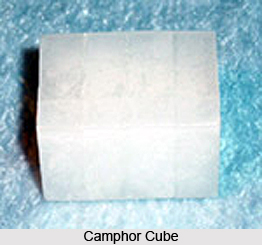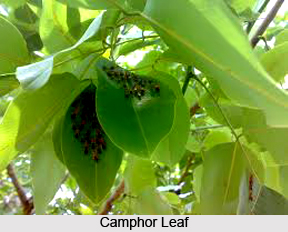 Botanical name:Cinnamomum camphora Nees.
Botanical name:Cinnamomum camphora Nees.
Family name:Lauraceae.
Indian names are as follows:
Hindi:Arom Kafoor, Kapoor
Bengali:Karpoor
Oriya:Karpoora
Sanskrit:Karpoor
Marathi:Kapoor.
English name:Camphor.
Camphor or Karpoor is well known for its aroma. In fact it is well known all over the world and is part of various religious and social rituals in entire Oriental world. However very few of us know that it is of plant origin.
The plant grows up to a height of 10 to 15 meters having small leaves, very thin and having three veins. Flowers are small, greenish yellow in color and appear during February/March. It has good aroma. Fruits appear there after resembles plum but having very thin skin. Seeds yield fatty oil and the flowers nectar. The wood extract yields a white crystal, which sold as camphor or karpoor. A plant yields 4 to 5 kgs of crystal.
The plant yields besides camphor, d-r-pinene, dipentene, terpineol, caryophyllene, cineol, l-linalool, geraniol, cadinene, safrole and camphoracene, all are odorous aromatics.
 Flowers yield nectar hence gives honey. The quality of honey is good having commercial demand. Beeping can be effectively planned during flowering season.
Flowers yield nectar hence gives honey. The quality of honey is good having commercial demand. Beeping can be effectively planned during flowering season.
Seed yield 42 % fatty oil. The oil contains 95% Lauric acid and 5% Oleic acid. Saponification value of the oil is 272.3 and its Iodine value is 4.0. it contains o.8% of Unsaponifiable matter.
Traditional folk practitioners use the oil as medicine. It can be used for manufacture of soap up to limited extent. Due to high proportion of Lauric acid, however, it may create problem of graining during the manufacture of soap. On the other hand, the presence of high proportion of Lauric acid shall not only ensure better foaming property but also ensure better dazzle of the skin. The oil can be used for manufacture of foam booster, glycerol and cosmetics.
Oil cake can be used for manufacture of industrial adhesives, plastics etc. it can be a good manure too. It can be further value added if the cake is used as feed to vermicomposting. It can also be used for manufacture of foam booster.
The plant yields much valued camphor crystals. Camphor is used in incense sticks for aroma, as mosquito repellant, for manufacture of cosmetics, in pharmaceutical industries and as perfume to soap etc. Camphor crystals are popularly used in India for flavoring food items, especially sweet dishes. In Orissa, particularly in coastal region, sweet dishes prepared out of coconut pulp (the dish is popular as `Kora`) and sweet dishes prepared out of puffed rice (popularly known as `Ukhura`) are well known for the special flavor especially due to flavor of camphor.  In Bengal and many other neighboring states camphor is often added in sweet dishes made out of milk such as `Kheer`. In some of the vegetable dishes also camphor is added for flavor and taste. Camphor is frequently added to dishes prepared as offerings to deities during various rituals, which are ultimately consumed.
In Bengal and many other neighboring states camphor is often added in sweet dishes made out of milk such as `Kheer`. In some of the vegetable dishes also camphor is added for flavor and taste. Camphor is frequently added to dishes prepared as offerings to deities during various rituals, which are ultimately consumed.
Use of camphor as medicine in India was known from 6th century onwards perhaps because Indians were not aware of the herb earlier. Only there after its references were available in various scriptures. There are references in Astangahridaya Samhita written by Bagbhatta. Chakrapani Dutta also made some references about camphor in his scriptures and documents.
During modern days camphor is being used as medicine frequently for various purposes. It is used both for internal and external applications. It is used for treatment of fever, whooping cough, asthma, mental diseases, cancer, urinary troubles and so on. It is used for preparing massage oil for external application to get relief from pain due to arthritis, rheumatism etc. It increases sexual excitement both in penis and vagina. However application of camphor as medicine should be done only in consultation with medical practitioners.
Considering all above background this plant may be effectively utilized for planning and implementing rural industrialization programme. Units may be for extraction of camphor crystals, or further value addition for manufacture of spices, medicines, cosmetics and so on.




















